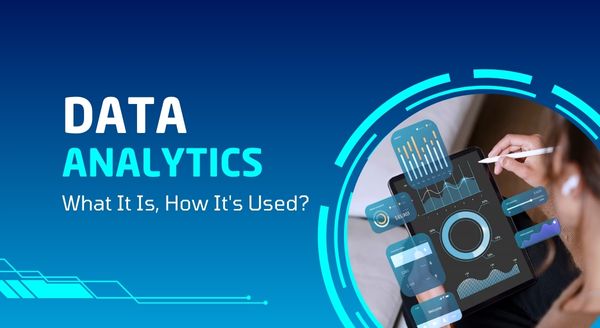The digital world is producing more data than ever today. And it’s simply full of opportunities. Do you know how?
Well, the data of customer interactions, online transactions, operational processes, inventory, or supply chain flows carry insights of different aspects. This information is like gold for businesses, which they turn into actionable insights. Technically, this process is called data analytics.
What Is Data Analytics?
Closely observing and meticulously auditing a raw piece of information to achieve a goal is data analytics. The goal can be discovering trends, patterns, correlations, and insights for making some crucial decisions. In the present scenarios, multiple AI-powered tools like Power BI, Tableau, etc., and techniques are available, which won’t require days but minutes to transform data into comprehensive information.
Types of Data Analytics
Majorly, four types of data analytics are available. These are the following:
- Descriptive Analytics
This analytics introduces you to specific answers of what happened by summarising historical data.
- Diagnostic Analytics
With this type of analytics, you can discover the cause of any problem or incident.
- Predictive Analytics
This analytics reveal possibilities of what next could happen. Simply put, it helps in foreseeing the possibilities.
- Prescriptive Analytics
This type of analytics helps in learning possible results or flexible strategies to execute.
Why Data Analytics Matters?
Certainly, this technique is a strategic approach, which guides thinkers, strategists, and innovators to get into insights and make decisions accordingly. Basically, it helps in achieving a wide range of goals, which reveal:
- How to increase operational efficiency
- How to improve customer experiences
- How to boost marketing ROI and leads
- How to reduce costs and risks
- How to evolve something new or undiscovered revenue streams
So, it helps in preparing a blueprint of strategies to stay ahead of your competitors in the niche. Various companies, including Fortune 500, rely on it.
How Data Analytics Is Used Across Industries?
It won’t be wrong if it is said that the penetration of data analytics is now in every industry. You can see its application in these industries prominently.
1. Retail & E-commerce
Retailers are now recognised as e-tailers as they electronically sell products. This platform helps them collect valuable customer data for profound analysis. When getting into insight, it introduces you to buyers’ behaviour, inventory status to optimise, and how to personalise marketing campaigns. Their meticulous monitoring guides retailers about what to recommend and promote to drive sales.
2. Healthcare
Healthcare institutions and clinics hold patient records, treatment details, and operational data. When these records are thoroughly examined, some incredible details come into the spotlight that might not have been tracked before. The driven insights resolve challenges in diagnostics. Moreover, patients’ wait time and care quality can be discovered via that data. So, the clinics and hospitals get accurate details, which help in improving their services. The patients’ reports can be used in achieving preventive breakthroughs and risk assessments.
3. Finance
Banking and finance companies are fond of analytics because it emerges as a silver lining in fraud detection. These companies track credit scoring and investment risks via users’ data, which help in personalising financial advice in real time for trading.
4. Manufacturing
Manufacturers leverage analytics to discover how to streamline production, reduce downtime, predict maintenance needs, etc. The data collected via sensors is mostly analysed to improve and proactively control quality.
5. Marketing & Advertising
The evolution of digital marketing has simplified understanding customers and their intent via demographics, engagement rates, and campaign performance. These insights help in refining targeting and personalising messages for overwhelming upselling and cross-selling. This very data can also uncover trends and customers’ preferences, which guide in discovering more opportunities.
6. Logistics & Supply Chain
The logistics data highlight challenges in deliveries and inventories. Once you discover the root causes, optimising deliveries, inventories, and other needs becomes a walkover. Further, you can easily foresee obstacles in the supply chain, which eventually saves your precious time and cost.
What Are Data Analytics Services?
Many businesses overwhelmingly request data analytics services from reputed outsourcers. They look for a reliable partner that can simplify insights into diverse datasets. Basically, they look for these services.
- Data collection and cleansing
The outsourcer helps in gathering pricing, discounts, and competitor data via web scraping. Then, the collected data is properly cleansed to convert it into a comprehensive structure for analysis.
- Data warehousing and management
This service is basically related to the storage and management of significant details. So, they hire BPM companies to securely manage their sensitive data without compromising its quality.
- Dashboard and reporting solutions
This is typically a step closer to discovering intelligence. The clean-up data is further visualised in a comprehensive dashboard to present as a report.
- Predictive and prescriptive modelling
The comprehensive dashboard is then deeply studied to predict trends and prospective customer or market behaviour. These solutions are conveniently conducted by integrating AI and machine learning tools. This is how analysis is carried out.
In essence, an outsourcing partner can guide you through various processes or workflows that lead to analysis. For this purpose, you don’t have to build or occupy an in-house team and IT infrastructure. Furthermore, the incorporated partner can tailor strategies according to your business prospects, which can be improving customer retention, forecasting demand, and identifying operational inefficiencies.
Tools & Technologies in Data Analytics
Several tools are utterly popular for examining data to catch insights effortlessly. Some of the most popular tools are the following:
- Excel & Google Sheets – These are widely popular for processing, managing, and analysing a precise range of data using their advanced AI-powered functions and basic analytics capacities.
- Power BI & Tableau – This alternative proves the best for visualising data to prepare a comprehensive report.
- SQL – This tool is helpful in querying databases.
- Python & R – These are programming languages that can help in meeting requirements for advanced statistical analysis and machine learning.
- Apache Hadoop & Spark – These alternatives have evolved to meet large-scale enterprises needs for big data processing.
- Google Analytics – This is typically recognised as the most successful and foremost tool to track web and digital marketing metrics for making further decisions to boost sales & online engagement.
Besides, there are certain more tools like AWS, Google Cloud, and Azure that can effortlessly and efficiently meet the need for scalable analytics solutions.
Conclusion
In essence, data analytics is widespread as a necessity to make informed decisions. It helps in discovering strategies that adapt to marketing changes and are more insightful. So, this process introduces you to real-time insights to set the narrative for the next plan of action, which can be to boost sales, enhance engagement, improve efficiency, and branding.



